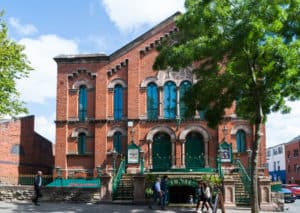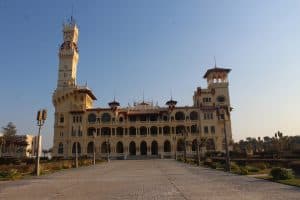Architectural Camouflage: The Art of Blending In

Updated On: March 10, 2024 by Raghda Elsabbagh
Have you ever heard of architectural camouflage? It’s a pretty cool design concept that blends buildings into their surroundings in a way that makes them almost invisible! Architects have used this technique for centuries, coming up with ingenious methods to hide buildings for various reasons ranging from aesthetics and functionality to security.
The art of camouflaged architecture allows buildings to coexist with nature harmoniously, blurring the lines between nature and manmade structures. Our journey into the world of camouflaged architecture takes us through a historical exploration of how different cultures and geographies have influenced these secretive structures and spaces.

We’ll delve into the materials, techniques, and planning that create these hidden gems and how environmental considerations play a significant role in integrating buildings into their surroundings. Thanks to modern advancements, the field of camouflaged architecture is constantly evolving, pushing the boundaries of what can be achieved and offering new ways to redefine our relationship with the spaces we live in and interact with.
The Essence of Architectural Camouflage
Architectural camouflage is a fascinating concept! Essentially, it means designing buildings to blend in with their surroundings, either to minimise their visual impact or to conceal them altogether.
Historical Evolution of Concealed Structures
Let’s journey through time and explore the fascinating evolution of camouflaged architecture! From the ancient camouflaging methods of caves to the modern-day advancements of clandestine design, there are so many secrets behind structures designed to be unseen.
Ancient Camouflage Techniques
It’s incredible to think that the history of concealed structures is as old as architecture itself. Early on, people used natural hideaways like caves, being naturally concealed and fortified by their rocky façades, to protect themselves. Soon, they mirrored these natural hideaways and began integrating camouflage techniques into built environments. For example, Egyptians disguised their tombs amidst the surrounding landscape to deter tomb raiders, while castles used subtle facades to conceal their defences and escape routes.
Modern Developments in Camouflaged Architecture
Fast forward to today, and architects have access to all sorts of cool technology that allows them to create buildings with façades that blend seamlessly with their environment. Just check out the Greenbrier Hotel in Sulphur Springs, West Virginia—it has a Cold War-era bunker hidden in plain sight! Likewise, some homes even have walls that are camouflaged doors, leading to private spaces or hidden rooms. It’s all about maintaining the appearance of continuity while creating innovative and functional spaces.
Geographical Influence on Hidden Designs

Can the location and surroundings of a building influence its design and even the way it’s hidden or disguised? It’s fascinating how architects can expertly blend buildings into their environment, whether in the middle of a bustling city or nature’s wild contours.
Integration in Urban Settings
For example, in a city like London, new buildings can be designed to match the historic surroundings, using materials and façade designs that mimic neighbouring Victorian brickwork to create a cohesive visual flow. This way, even though the new structures are modern, they still fit in with the surrounding historic buildings and maintain the city’s visual landscape.
Concealment in Natural Landscapes
Moving outside the urban jungle, in stark contrast to London’s historical consistency, architects use the desert backdrop to their advantage in places like Palm Springs by creating low-lying structures with earthy palettes that blend seamlessly into the arid surroundings. Similarly, in Australia’s diverse landscapes, they use local flora and reflective materials to make the building almost invisible, minimising their visual impact on the surrounding hills and mountains.
Building Materials and Structural Innovations

Let’s explore how architects can create buildings that blend seamlessly into their surroundings. It’s all about using suitable materials and innovative techniques that combine the best of both traditional and modern advanced approaches.
Natural Elements in Construction
One trend we’ve noticed is the increased use of natural elements like rocks and boulders in construction. These materials not only look beautiful but also offer excellent durability and sustainability. By incorporating these organic elements into a building’s design, architects can create structures that harmonise with the local topography and coexist with the environment. For example, subterranean homes in Greece take cues from the landscape, blending in perfectly with the surrounding hills and valleys.
- Rock: Utilised for its durability and thermal mass
- Boulders: Strategically placed to merge with the topology
Advanced Materials for Invisibility
But what about buildings that need to disappear from view? Well, that’s where advanced materials come in. Innovations like reflective glass and adaptive skins can mimic the environment around them, allowing structures to blend in so well that they become nearly invisible. This is especially useful when preserving historical aesthetics while introducing modern capabilities, as seen in buildings with deceiving façades.
- Reflective Surfaces: Mirror-like materials reflecting the environment
- Adaptive Skins: Cladding that responds to visual stimuli
Using these materials and techniques, architects shape a sustainable and harmoniously integrated built environment that honours the past, engages with the present and looks towards the future.
Environmental Considerations

When it comes to architecture, architects believe it’s essential to consider the environment by making sustainable choices and selecting eco-friendly materials. Doing so can minimise the ecological footprint and enhance the buildings’ relationship with their surroundings.
Sustainable Practices in Camouflaged Architecture
One way architects achieve this is by using sustainable practices in their designs. By carefully considering the topography of a site, they can design buildings that preserve the natural landscape, reducing the need for extensive excavation and retaining walls. Green roofs are another hallmark of eco-conscious design, providing insulation, reducing rainwater runoff, and fostering biodiversity. By aligning the structures with the terrain and choosing designs that coexist with the natural setting, they show their commitment to sustainability.
Eco-Friendly Materials and Green Roofs
Of course, choosing eco-friendly materials is also crucial. Architects advocate using locally sourced, recycled, or renewable building materials that reduce transport emissions and support local economies. And when they incorporate green roofs into their designs, they create a living system that not only insulates but also purifies the air. These roofs can even become luscious gardens that mirror the topography, blurring the line between the built and natural environment while actively contributing to urban sustainability.
Camouflage Techniques in Modern Architecture
So, how do buildings blend in almost seamlessly with their surroundings? That’s thanks to some pretty sophisticated camouflage techniques that architects use these days. By prioritising the visual integration of a building with its environment, architects can reduce its visual impact while still creating something beautiful and functional.
Façade Treatments
One way they do this is through façade treatments.
- Reflective Materials: Mirror-like surfaces can make a building almost disappear during certain times of the day by reflecting the surrounding scenery.
- Green Walls: Plants covering the exterior, also known as living walls, help structures merge with greenery.
Design Strategies
Design strategies are also essential.
- Contouring: Building forms that mimic the natural landforms or “contours” of the site.
- Break-up Patterns: Applying patterns that break-up the façade’s shape, making it harder to discern against the background.
The result is a building that blends in so well that it almost disappears, like the outhouse structure by Robert Walsh that vanishes in the daylight and maintains uninterrupted views through its glass walls.
Overall, architects are finding inventive ways to create buildings that uphold the landscape’s integrity. This blending in is a fascinating aspect of modern architecture, where the environmental impact is minimised, and the structures transform into hidden spaces within the natural or urban fabric.
The Relationship Between Architecture and Topography

The relationship between architecture and topography is crucial in shaping a structure’s character—it can influence everything from a building’s form and orientation to its insulation, optimal sunlight exposure, and water drainage.
When considering topography, architects often use strategies that respect and enhance the natural landscape when designing their buildings. For example, structures nestled into hills can minimise their visual impact and preserve skyline views. Buildings that follow the land’s natural slope can reduce the need for extensive ground modification.
This synergy between architecture and topography isn’t just about aesthetics but also functionality. By using the earth as insulation or allowing for natural water drainage through site-specific design, architects can create more sustainable and eco-friendly structures.
Furthermore, the fusion of architecture and landscape can lead to some cool hidden spaces and secret places. A hillside might conceal an underground home, or a mountainside might reveal camouflaged living spaces that are invisible from certain vantage points. These hidden marvels are a testament to how architecture can converse with its environment and create something truly unique and special.
Overall, there’s no denying the importance of the relationship between architecture and topography. By working with the natural landscape, architects can create buildings that look beautiful and function in harmony with their surroundings.
Case Studies of Hidden Structures Globally
We’ve uncovered some genuinely excellent structures that showcase the ingenuity of designers who have blended form with function to create both concealed and revealing spaces.
Famous Hidden Buildings Around the World
- Camouflaged Abodes: In Shoolagiri, Vinu Daniel has mastered the art of camouflaged architecture, designing buildings that blend so well with their environment, often rendering them invisible to the untrained eye.
- Subtle Transitions: The concept of camouflaged and hidden doors has intrigued many. These entrances are so deftly integrated into walls that they appear as seamless extensions of the surface, cleverly concealing what lies beyond.
Notable Secret Spaces and Their Purposes
- Constructive Disguise: But these hidden spaces aren’t just about aesthetics—they often serve specific purposes, from preserving views to protecting wildlife. Camouflaged architecture, for example, can help integrate structures within landscapes and minimise their environmental impact.
- Legacy of Conflict: Hidden barriers in Belfast, documented in a case study, have served as physical reminders of past conflicts, subtly influencing the city’s architecture and impacting social dynamics.
By exploring the hidden facets of global architecture, we gain a deeper appreciation for the creativity and thoughtfulness that mould our environment and the way we interact with it. Though often unseen, these structures play a significant role in shaping our world and our understanding of space.
Design and Planning for Stealthy Structures
Designing a stealthy structure isn’t easy—it takes meticulous planning and research to achieve its hidden qualities. At each step, architects consider every element, from materials to landscaping, to ensure the structure blends seamlessly with its surroundings.
First, architects analyse the site carefully, looking for natural patterns and visual cues that inform their designs. This helps them choose suitable construction materials—from reflective surfaces that mimic the environment to local flora that aids in the concealment.
But it’s not just about the materials—they also have to think about the design itself. For example, a hidden room might leverage a bookshelf door or a camouflaged panel, requiring clever solutions to make them practical yet undetectable. When planning for hidden escape routes or panic rooms, they must use complex engineering to ensure they remain invisible until needed.
Their approach is guided by a table of elements that align with their goals:
| Aspect | Consideration |
|---|---|
| Landscape Harmony | Natural contouring and native species |
| Architectural Flow | Non-intrusive, context-aware design |
| Material Selection | Environment-reflecting or absorptive |
| Mechanical Systems | Noise-reducing, low profile components |
They refine these components until they’re confident the structure is truly stealthy. By collaborating with experts in various fields, they engineer both functional and nearly imperceptible spaces, reinforcing their commitment to the art of hidden design.
Cultural and Social Aspects of Architectural Camouflage

Architectural camouflage isn’t just about aesthetics—it’s also intricately woven into society’s cultural and social fabric. At its core, it represents a unique synthesis of art, design, and practicality, reflecting the context in which it is situated.
- Cultural Identity: We see buildings blending into their settings, reflecting a desire to retain cultural integrity. These structures often take inspiration from historical and natural elements, becoming part of a larger story and sustaining a connection with the environment and the culture’s heritage.
- Social Commentary: Camouflaged architecture can serve as a statement, subtly challenging class dynamics or touching on issues such as the housing crisis. This reflective approach allows architects to shape the dialogue on social issues through design indirectly.
- Contextual Adaptation: The relationship between a building and its immediate surroundings is critical. Through architectural camouflage, we demonstrate an understanding and respect for the local context, ensuring structures don’t overwhelm but rather complement their settings.
- Urban Narrative: In urban landscapes, camouflaged architecture often embodies the dynamic interplay between modernity and tradition. It helps to maintain a connection to the past while adapting to contemporary social needs, seamlessly integrating new developments into the established urban fabric.
Overall, architectural camouflage is a deliberate, culturally sensitive approach that considers both a building’s unique impact on the spaces we inhabit and its resonance with the social fabric surrounding it. It’s an exciting and essential part of modern architecture that we believe will continue to shape our world for years to come.
The Future of Camouflaged Architecture

As we look towards the future of urban development, the integration of stealthy design is becoming more prominent thanks to new technologies that enable buildings to blend into their surroundings and serve multiple functions, from residences to exhibition spaces.
Technological Advancements
Technological advancements have opened up a world of possibilities regarding architectural camouflage. Materials with adaptive capabilities, like those that can change colour or texture to match their environment, are becoming more sophisticated. We’re seeing the emergence of smart glass that can adjust transparency and even project images, effectively turning building facades into dynamic screens that are both visually impressive and practical. They improve energy efficiency and privacy.
We’re also seeing the emergence of reconnaissance technology, influenced by military applications, being repurposed for architectural use. Buildings with integrated cameras and sensors can now better understand and react to their surroundings, making them safer and more responsive to occupants’ needs.
Predictions for Camouflaged Architecture
Looking ahead, we predict camouflaged architecture will become more prevalent in urban environments where space is at a premium and privacy is coveted. Buildings designed to serve dual purposes, like those operating as both an office and an exhibition space, will likely become more common. Research into materials and building methods will probably evolve to focus on reducing environmental impact while maximising camouflage’s aesthetic and practical benefits.
We also expect increased demand for hidden and secret spaces within structures, like multifunctional rooms, that can be concealed and revealed as needed. This could be particularly useful for research facilities that require discretion or for homeowners who desire hidden rooms for safety or personal reasons. The dichotomy of visibility on demand, paired with concealment for privacy, is likely to define the urban architectural landscape of the future.
Overall, the future of disguised developments is exciting and full of possibilities, from innovative materials to multifunctional spaces. There’s so much to learn and explore; we’re excited to reveal the secrets behind these fascinating structures designed to be unseen. It’s an exciting time to be a part of this innovative field!
Frequently Asked Questions
In our exploration of architectural camouflage, we address several queries that arise when discussing the integration of hidden structures and secret spaces within diverse environments.
What principles guide the design of structures intended to blend into their surroundings?
The design of structures to merge seamlessly with their environment relies on principles such as mimetic architecture, where buildings imitate specific shapes and forms found in nature and use materials that reflect the textures and colours of the immediate landscape. Emphasis is also placed on scale, proportion, and the play of light and shadow to ensure a building complements its setting.
How is the caryatid used as an architectural element to conceal structural supports?
The caryatid, a sculpted female figure serving as an architectural support, is a classic element that beautifully marries form and function. These statuesque forms conceal the practical purpose of holding up buildings and add a layer of visual intrigue, as seen in structures like the Erechtheion on the Acropolis in Athens.
Can you elaborate on the techniques employed in camouflaging residential buildings?
Architects use methods such as reflective and green roofs, strategic planting, and earth-sheltered designs to blend residential buildings into their settings. Materials are selected to harmonise with the local environment, and the building’s footprint is often designed to minimise visual impact, as demonstrated by homes that appear as extensions of the natural landscape.
What role does landscaping play in the concealment of architectural elements?
Landscaping is a critical component in camouflaged architecture, used to disguise edges and borders through naturalistic plantings and to draw the eye away from manmade structures. Dense foliage, cascading green walls, and curated gardens are crafted to enhance the illusion of a building’s continuity with the environment.
In what ways do architects balance aesthetic appeal and functionality in hidden structures?
Architects strive for a symbiosis between aesthetic appeal and utility by choosing innovative materials and construction methods that serve a structure’s purpose while also enhancing its appearance. Hidden structures often incorporate sleek, unobtrusive design features that serve their intended function without detracting from the visual flow of the space.
Could you discuss examples of architectural camouflage successfully implemented in urban environments?
Urban examples of architectural camouflage range from facades that mirror the cityscape to pocket parks that vanish into the urban fabric. The qualities of surrounding buildings are often replicated in new constructions to maintain a continuous streetscape, such as camouflaged doors and entrances that are indistinguishable from adjacent walls.






